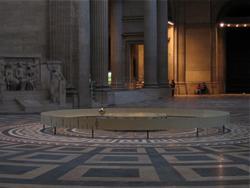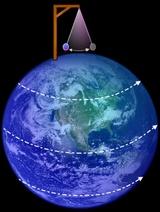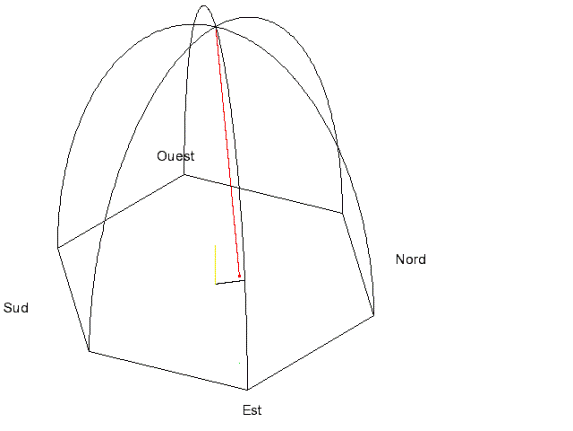
Тысячи-1 / Маятник Фуко / Foucault pendulum speech - Print
.docFoucault pendulum
The Foucault pendulum (pronounced /fuːˈkoʊ/ "foo-KOH"), or Foucault's pendulum, named after the French physicist Léon Foucault, was conceived as an experiment to demonstrate the rotation of the Earth.

Foucault's Pendulum in the Panthéon, Paris.
The experiment
The experimental apparatus consists of a tall pendulum free to oscillate in any vertical plane. The direction along which the pendulum swings rotates with time because of Earth's daily rotation. The first public exhibition of a Foucault pendulum took place in February 1851 in the Meridian Room of the Paris Observatory. A few weeks later, Foucault made his most famous pendulum when he suspended a 28-kg bob with a 67-metre wire from the dome of the Panthéon in Paris. The plane of the pendulum's swing rotated clockwise 11° per hour, making a full circle in 32.7 hours.

![]()
A Foucault pendulum at the north pole. The pendulum swings in the same plane as the Earth rotates beneath it.
In 1851 it was well known that Earth rotated: observational evidence included Earth's measured polar flattening and equatorial bulge. However, Foucault's pendulum was the first dynamic proof of the rotation in an easy-to-see experiment, and it created a sensation in both the learned and everyday worlds.

![]()
Animation of a Foucault pendulum at the Pantheon in Paris (48°52' North), with the earth's rotation rate greatly exaggerated. The green trace shows the path of the pendulum bob over the ground (a rotating reference frame), while the blue trace shows the path in a frame of reference rotating with the plane of the pendulum.
At either the North Pole or South Pole, the plane of oscillation of a pendulum remains fixed with respect to the fixed stars while Earth rotates underneath it, taking one sidereal day to complete a rotation. So relative to Earth, the plane of oscillation of a pendulum at the North or South Pole undergoes a full clockwise or counterclockwise rotation during one day, respectively. When a Foucault pendulum is suspended on the equator, the plane of oscillation remains fixed relative to Earth. At other latitudes, the plane of oscillation precesses relative to Earth, but slower than at the pole; the angular speed, α (measured in clockwise degrees per sidereal day), is proportional to the sine of the latitude, φ:
![]()
Here, latitudes north and south of the equator are defined as positive and negative, respectively. For example, a Foucault pendulum at 30° south latitude, viewed from above by an earthbound observer, rotates counterclockwise 180° in one day.
In order to demonstrate the rotation of the Earth without the philosophical complication of the latitudinal dependence, Foucault named the gyroscope in 1852. The gyroscope's spinning rotor tracks the stars directly. Its axis of rotation is observed to return to its original orientation with respect to the earth after one day whatever the latitude, unaffected by the sine factor.
A Foucault pendulum requires care to set up because imprecise construction can cause additional veering which masks the terrestrial effect. The initial launch of the pendulum is critical; the traditional way to do this is to use a flame to burn through a thread which temporarily holds the bob in its starting position, thus avoiding unwanted sideways motion. Air resistance damps the oscillation, so Foucault pendulums in museums often incorporate an electromagnetic or other drive to keep the bob swinging; others are restarted regularly. In the latter case, a launching ceremony may be performed as an added show.
The dynamics of the Foucault pendulum

Change of direction of the plane of swing of the pendulum in angle per sidereal day as a function of latitude. The pendulum rotates in the anticlockwise (positive) direction on the southern hemisphere and in the clockwise (negative) direction on the northern hemisphere. The only points where the pendulum returns to its original orientation after one day are the poles and the equator.
From
the perspective of an inertial frame outside of Earth, the suspension
point of the pendulum traces out a circular path during one sidereal
day. No forces act to make the plane of oscillation of the
pendulum rotate - the plane contains the plumb line, so the force
acting on the pendulum is parallel to the plane of oscillation at all
times. But the plane satisfies the constraint
that it contains the plumb line. Thus the plane of oscillation
undergoes parallel
transport. The difference between initial and final orientations
is
![]() as
given by the Gauss-Bonnet
theorem. α
is also called the holonomy
or geometric
phase of the pendulum. Thus, when analyzing earthbound motions,
the Earth frame is not an inertial
frame, but rather rotates about the local vertical at an
effective rate of
as
given by the Gauss-Bonnet
theorem. α
is also called the holonomy
or geometric
phase of the pendulum. Thus, when analyzing earthbound motions,
the Earth frame is not an inertial
frame, but rather rotates about the local vertical at an
effective rate of
![]() radians
per day, which is the magnitude
of the projection
of the angular
velocity of Earth onto the normal
direction to Earth.
radians
per day, which is the magnitude
of the projection
of the angular
velocity of Earth onto the normal
direction to Earth.
From the perspective of an Earth-bound coordinate system with its x-axis pointing east and its y-axis pointing north, the precession of the pendulum is explained by the Coriolis force. Consider a planar pendulum with natural frequency ω in the small angle approximation. There are two forces acting on the pendulum bob: the restoring force provided by gravity and the wire, and the Coriolis force. The Coriolis force at latitude φ is horizontal in the small angle approximation and is given by

where Ω is the rotational frequency of Earth, Fc,x is the component of the Coriolis force in the x-direction and Fc,y is the component of the Coriolis force in the y-direction.
The restoring force, in the small angle approximation, is given by


![]()
Animation of a Foucault pendulum showing the direction of rotation on the southern hemisphere. The rate of rotation is greatly exaggerated. A real Foucault pendulum, released from rest, does not pass directly over its equilibrium position as the one in the animation does.
Using Newton's laws of motion this leads to the system of equations

Switching to complex coordinates z = x + iy the equations read
![]()
To first order in Ω / ω this equation has the solution
![]()
If
we measure time in days, then Ω
= 2π
and we see that the pendulum rotates by an angle of
![]() during
one day.
during
one day.
